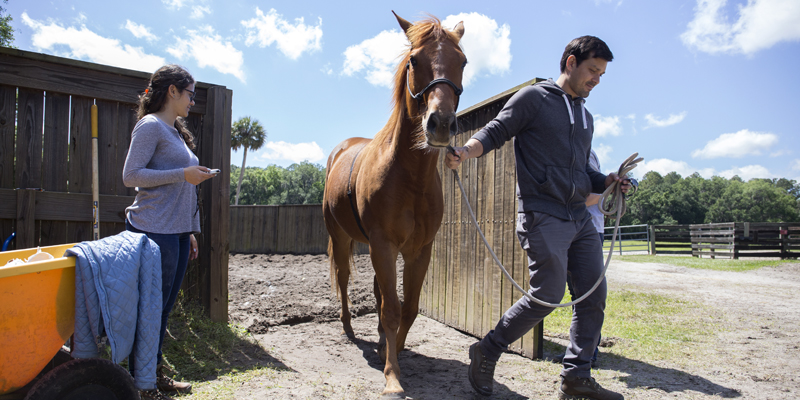Brooks Equine Genetics Lab
Size Study

Project Description
Morphometrics And QTL Mapping Of Skeletal Variation In The Horse (aka “The Size Study”) - in collaboration with Dr. Nathan Sutter.
What makes your horse different from the horse in the stall over? Why doesn’t a Kentucky Derby contender walk like a Budweiser Clydesdale? Why don’t either of them look like Thumbelina, the current Guinness World Record holder for the world’s smallest living horse? The domestic horse comes in a range of sizes, shapes, and temperaments from the tiny American Miniature Horse to the massive draft breeds, humans have historically bred horses for both aesthetic and functional qualities. For the horse in particular, size and conformation have been two major driving forces for the development of the diverse breeds we see today. Horses have been bred to pull carts, jump fences, or run a mile-long race. When horse breeders look to improve these abilities in their stock, they are often selecting for changes in genes, called alleles, that affect body size and conformation.
Allele variation in several genes has already been shown to contribute to body size diversity in many species. As body size genes affect fundamental developmental processes such as cell growth, they can sometimes be correlated to other diseases, like the tumor growth seen in cancer. By exploring the genetics of body size in the horse, we hope to improve not only the livelihood of the horse population, but also better understand the genetics of diseases that affect all mammals, including humans. Furthermore, when we investigate body size genes, we will look for genes that contribute to breed-specific traits in the horse, especially conformation and skeletal qualities valued by breeders.
Body size and complex disease genes can only be identified through the DNA analysis of hundreds of horses from many different breeds and types. Your horse has a unique pattern of genes that, when compared to other horses, can give a clue to the genes and interactions that control body size. DNA can be isolated from almost any cell in the body, and in this case the skin tags from a routine tail hair pull will supply more than enough DNA for us to analyze. In addition to this hair sample, our study will require a profile photo, 3-generation pedigree, and 35 measurements of your horse. These measurements will help us judge the size and conformation of your horse relative to other horses, and are an essential component of our study. The entire process should take only about 15 minutes of your time per horse. All information is strictly confidential.
Every individual horse is an important contribution to our study and another step towards improving the quality of life for both horses and humans.
Does this study sound familiar? You may have seen information about this study in some of your favorite equine publications such as:
The Blood-Horse, No. 24, June 13, 2009, p.2111
The Horse, June 2009, p.18
Equus, July 2009, p.12
Practical Horseman, July 2009, p.72
Horse and Rider, August 2009
Measurement Instructions
Before you begin, make sure your horse is standing on even ground. Measurements should be recorded in inches. Please do not attempt to measure an unwilling horse. We appreciate your contribution to our equine genetics research.
-
Size Study: FAQ
What breeds of horse are you looking for?
Do you accept crosses?We need all breeds and all sizes! Crosses are also acceptable. It is very important that we have a pedigree for your horse. We need to determine the relatedness of individual horses as well as any breed crosses. We will also accept an unregistered horse if both the sire and dam are registered and both of their pedigrees are available.
My horse has a few years on him; do you have an age limit?
Every horse in our study has to be at least 4 years old, but there is no maximum age limit.
What will I find out about my horse?
There won’t be any specific results for an individual horse. Your horse will be a representative of his or her breed and body type. The unique genetic information from each horse will be combined with similar horses to help tell us exactly how that particular breed or body type came to be. We need the whole range of sizes and types within a breed and each horse is a valuable addition to the study.
What kinds of measurements do I have to take?
What kind of measuring tape do I use?We will include a measuring tape with your kit to measure your horses with. To see how to take all 35 measurements, please see Horse Measurement Instructions.
My horse has a few old injuries, can he still be used?
It is important to note if your horse has any diseases and/or injuries. All of the measurements are taken on the horse’s left side, so it is especially important to know about any injuries on that side. You may take a measurement on the horse’s right side if the injury to the left side has caused a structural abnormality.
What costs are associated with this study?
This study needs mostly your time and effort. There is a small postage fee to return completed kits with the average being $2-$3 to return up to 10 kits.
How long is the hair sample good for?
Will I have to keep pulling fresh hair samples for the study?Hair samples, if kept in a cool, dry place, will last for years. We keep all submitted hair samples in manila envelopes and store them out of direct sunlight. We do not recommend storing hair samples in plastic baggies for long term storage, as any trapped moisture will damage the sample. The 20-30 hairs that you originally pull for the kit will last us through the duration of the study. It is best to pull hair instead of taking samples from a brush. Hair found on brushes tends to be broken and missing the hair bulb and there is also concern about contamination from other horses.
Will I have to draw blood from my horse?
Blood draws are not necessary for this study. The hair that you pull from your horse’s mane or tail is sufficient for what we need. However, blood does yield more DNA with higher purity than hair, so we would certainly accept blood samples if you would like to send them. Please e-mail or call the Sutter Lab at sutterlab@cornell.edu or 607-253-3592 to receive blood tubes and specific instructions.
Can you accept samples and measurements from other countries?
Yes! We can import hair and blood samples from many other countries. Please contact the Brooks Lab for more information.

Contact
SAMANTHA BROOKS
Associate Professor, Equine Physiology
samantha.brooks@ufl.edu
